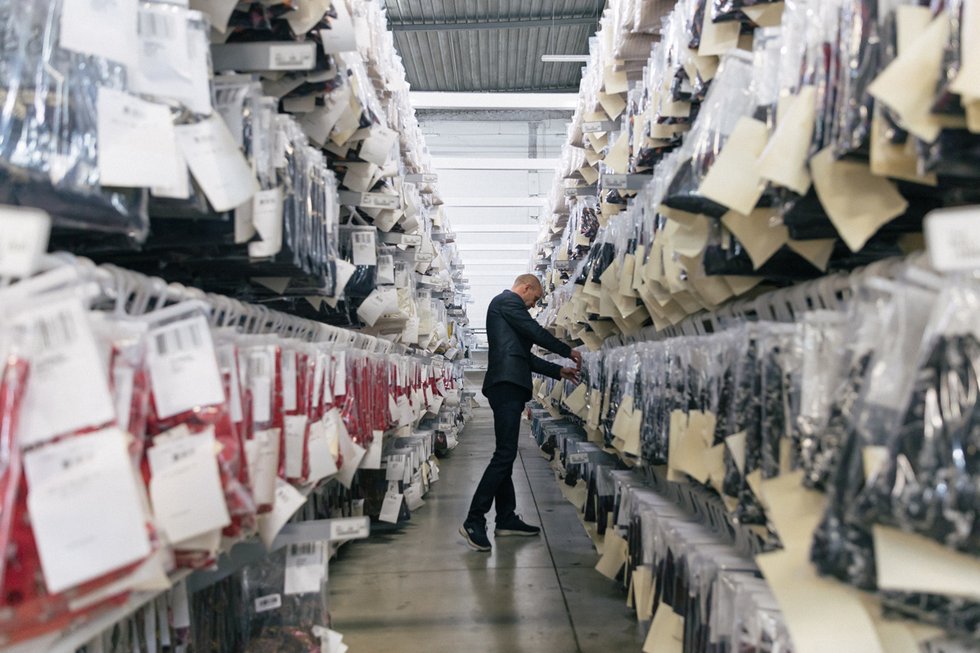Logistics Manager: A Powerhouse Behind the Distribution Chain
Aug 14, 2019
5 mins

After working in sales for a decade, Wilfried Doucet, 41, became the logistics manager for ba&sh, a women’s ready-to-wear label. With a warehouse that measures 9,000 square meters and supplies more than 300 stores, he oversees incoming merchandise from the fashion brand’s factories, inventory management, and shipping for orders from stores and the internet. It’s a profession that requires a highly developed managerial capacity when it comes to effort, tight deadlines, and organization.
How did you become a logistics manager?
I began my sales career at Office Depot and worked there as a store manager for eight years. After that initial experience, I worked for the retail group Auchan and then for a company called Cultura, where I was in charge of setting up e-commerce services. As their logistics and operations manager, it was my job to develop online sales for a range of recreational products, from books to art and craft supplies. I had to organize the supply chain for the physical flow of merchandise, from receiving products from suppliers to distributing customers’ orders. After more than four years at Aldi and then a short stint at Servair, I was hired as the logistics manager for ba&sh, a women’s ready-to-wear brand, in October 2018.
What does your job involve in concrete terms?
I’m in charge of supervising and coordinating the logistical operations for a warehouse that measures 9,000 square meters and supplies no fewer than 300 points of sale. That means I’m responsible for managing stock and the flow of incoming and outgoing merchandise, which comes from suppliers and gets shipped out to ba&sh stores, multi-brand distributors, or our online customers.

What are your everyday responsibilities?
As a logistics manager, I act as an intermediary between the purchasing department, which coordinates the receipt of goods; the supply department, which manages the quantities sent to the points of sale; and the sales department, which sells the brand’s products. In the world of retail, and especially ready-to-wear, our success depends on critical periods throughout the year. There are annual private sales, seasonal sales, end-of-year holidays, and then peaks at the start of each month that coincide with payday for many consumers.
As a logistics manager, I act as an intermediary between the purchasing department,. . . the supply department, . . . and the sales department. . .
The goal is to ensure that staff schedules relating to receiving orders, managing stock, and preparing orders are in line with these peaks in business activity. That way, every department in the company—especially purchasing, supply, and retail—has maximum visibility and can plan accordingly. Our top priority is making sure that delivery times, together with the quality and quantity of orders, are respected. The crux of the matter is really about keeping in control of the stock.

Could you describe a typical day in your warehouse?
I’m always the first to arrive, at about 5.30 AM. I begin by looking at the volume of sales made overnight on the website as well as the quantities we must ship to the points of sale. Then, when my teams arrive at 6.30 AM, we set out the day’s priorities for each department, which might involve receiving merchandise, preparing orders, managing returns, shipping online orders, and so on. Our morning update is a crucial moment: it’s when I must give my employees a much-needed energy boost for the day, because it often gets pretty intense.
In the morning, we prepare online orders that came through overnight and we also replenish the stock in stores. We collect items from around the warehouse, pack them up, and ship them off. We do the same thing at 1 PM for orders that came in before noon; then, depending on the volume, we do it all again mid-afternoon so we don’t fall behind the following day. By late afternoon, I send a warehouse activity report to management, which details the number of items sent, any recorded stock shortages, the number of items received, and the number of returns carried out. I usually leave between 7 PM and 8 PM.
Our morning update is a crucial moment: it’s when I must give my employees a much-needed energy boost for the day, because it often gets pretty intense.
Who are your clients and what are their specific logistical needs?
I have a range of clients: the end customer who buys from the brand’s website, internal clients, which are our ba&sh stores, and then wholesalers, or multi-brand distributors, such as Galeries Lafayette, who buy a range of products from us every season. The logistical approach for each one of these three customer types is very different. If there’s a shortage of stock at an external distributor, I lose a sale. On the other hand, if the shortage occurs in one of our brand stores, I draw on other technical means to manage the situation. For example, we can transfer the product if it’s available in another store or we can arrange to restock the item in question.
For the website, the logistics department is responsible for minimizing the time it takes to ship an item from the warehouse after the order has been placed. When customers receive an item earlier than expected, this enhances their experience of shopping and customer service. They are satisfied and more likely to return to our website to make purchases. It’s a race against the clock.
What main challenges do logistics managers encounter?
No two days are the same, and there’s never a day when we have nothing to do. Every morning, we find out what the next few hours will look like. That means we must know how to manage order volumes quickly, and to be responsive and vigilant as far as the quality of our products is concerned.

The human aspect is a fundamental part of the job because I manage a team of around 50 staff with very different profiles, from lower to higher levels of education. I need to speak in such a way that is accessible to everyone. Since working in a warehouse is also intense and rather physical, you must successfully motivate your teams and always be ready to communicate with them in a way that is dynamic, meaningful, and upbeat.
The human aspect is a fundamental part of the job because I manage a team of around 50 staff with very different profiles
How do you keep up with this pace?
I’m not superhuman, but I’ve always enjoyed working in fast-paced environments. I need to move, to have regular contact with my teams. I could never sit in front of my computer all day, it’s just not in my DNA. My secret is that I take short breaks throughout the day when I can get a change of scene and the chance to recharge my batteries. At the warehouse, we frequently organize informal events or activities, which helps to build bonds and fosters good relations between coworkers. I think that’s super important.
What qualities make a good logistics manager?
You must always be willing to take a long, hard look at things and know how to deal with contingencies such as late deliveries due to transport strikes or manufacturing problems in factories. It’s important to be a good listener and understand the problems faced by warehouse teams and different departments within the company, so you can constantly improve processes and ensure that everyone works well together.

What are your favorite parts of the job?
What motivates me the most is working for the well-being of my teams, to help my employees develop. I find it particularly rewarding to be around people who are happy to follow my lead, who want to work with me, and who trust me. At the warehouse, I often say that we are like a family, where every victory is a collective success that unites us.
What’s more, this profession is continually changing. We must try and do better by improving our organization and ways of working. When store teams tell us that their day-to-day lives have improved thanks to us, that’s seriously rewarding.
What advice would you give young people interested in becoming a logistics manager?
Unlike some professions, logistics will always be an indispensable part of commerce, and even more so with e-commerce. However, that doesn’t mean you can rely on your knowledge and skills. When it comes to transport, machinery and computers, new technologies are coming out all the time that have a direct impact on our everyday business. So you must be ready and willing to adapt quickly. Anyone who wants to go into logistics must bear in mind that tomorrow’s reality looks nothing like it does today.

Photos: Welcome to the Jungle
Translated by Andrea Schwam
Follow Welcome to the Jungle on Facebook and sign up for our newsletter to receive our articles every week

More inspiration: Sectors & jobs

The good, the bad, and the ugly behind seasonal work
Seasonal work can allow you to travel the world, learn new skills and meet new people, but is it all sunshine and roses?
Jul 17, 2024

What about the jobs ChatGPT could create?
While warnings of a labor apocalypse grow louder, some experts believe AI will increase demand for human workers
Feb 20, 2023

What if college isn’t the only route to success
As the US suffers from a shortage of plumbers and electricians, becoming a tradesperson can be very lucrative. So why do so few Americans consider it?
Jan 11, 2023

5 big data careers that just keep growing
“Big data” is currently one of the most sought-after areas of tech expertise. But what are the different roles you could take?
Apr 27, 2022

Product owner vs product manager – What’s the difference?
Product managers and product owners are multidisciplinary roles that create new products and improve ones that already exist... Huh?
Mar 17, 2022
The newsletter that does the job
Want to keep up with the latest articles? Twice a week you can receive stories, jobs, and tips in your inbox.

Looking for your next job?
Over 200,000 people have found a job with Welcome to the Jungle.
Explore jobs